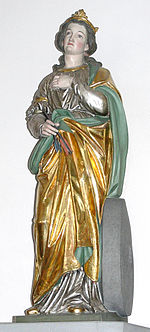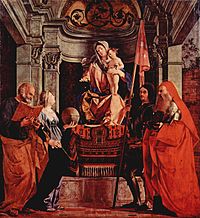- Christina of Bolsena
-
Saint Christina of Bolsena 
St Christina, by Moriz Schlachter, (c.1889)Virgin and Martyr Born 3rd Century
Persia (modern-day Iraq and Iran) or Tyre, LebanonDied 3rd Century
Bolsena, Tuscany, ItalyHonored in Eastern Orthodox Canonized Pre-Congregation Major shrine Toffia, Italy; Palermo, Sicily, Italy Feast 24 July Saint Christina of Bolsena, also known as Christina of Tyre, or in the Eastern Orthodox Church as Christina the Great Martyr,[1] is venerated as a Christian martyr of the 3rd century.
Archaeological excavations of an underground cemetery constructed at her tomb have shown that she was venerated at Bolsena by the fourth century.
Contents
Legend of Saint Christina
 Lorenzo Lotto, Virgin Mary, Saint Peter, Saint Christina of Bolsena, Saint Liberalis and Saint Jerome.
Lorenzo Lotto, Virgin Mary, Saint Peter, Saint Christina of Bolsena, Saint Liberalis and Saint Jerome.
However, nothing is now known about her life. But by the ninth century, an account of her martyrdom was composed, which developed many variants. According to these, she was born either in Tyre (Eastern stories) or in Persia (Western stories) during the 3rd century or 5th century.
While the accounts of her martyrdom vary widely, they seem to agree on some details: Christina was the daughter of a wealthy pagan magistrate named Urbanus who had his daughter tortured because of her faith, but God thwarted his efforts on several occasions. The nature of the torture varies with each telling, and can include iron hooks, grilling by fire, placement in a furnace, torture on the wheel, assault by snakes, assailment by arrows, drowning tied to a millstone, and other assorted methods which she survives. After her father's death, his successor, Dion, continued to torture her. In all versions of the tale Christina eventually perishes, but not before God exhibits his wrath by lashing out at her tormentors.
Some scholars have concluded that her legend is the result of pious fiction being mistaken for history. The theme of her legend (a beautiful Christian maiden is tortured to death by pagan men, who in return suffer the wrath of God) is repeated in many ancient and medieval hagiographies, particularly that of Saint Barbara.
Roman Catholic veneration
The entry for her in the 2004 Roman Martyrology is very brief: "At Bolsena in Tuscany, Saint Christina, Virgin and Martyr". This saint was once included in the Roman Catholic Calendar of Saints to be commemorated universally, wherever the Roman Rite was celebrated, but, while her cult remains approved, she was removed from that list in 1969, "because nothing is known of this virgin and martyr apart from her name and her burial at Bolsena." [2] The Tridentine Calendar gave her a Commemoration within the Mass of the Vigil of Saint James. When in 1955 Pope Pius XII suppressed this vigil,[3] the celebration of Saint Christina became a "Simple" and in 1962 a "Commemoration".[4] According to the rules in later editions of the Roman Missal, Saint Christina may now be celebrated with a "Memorial" everywhere on her feast day, unless in some locality an obligatory celebration is assigned to that day.[5]
Relics
Toffia in the Province of Rieti displays her relics in a transparent urn. Palermo, of which Christina is one of four patron saints, also claims to hold her relics.[citation needed]
The Eastern tradition that connects Saint Christina with Tyre, Lebanon may be due to confusion with the name of a locality near Bolsena.
The Cathedral of St. John the Evangelist in Cleveland Ohio claims "In the Resurrection Chapel, below the altar, is the reliquary of St. Christine, including her entire skeleton and small vial of her blood. The relics were presented to Archbishop Schrembs in 1928 by Pope Pius XI. Tradition says that Christina was a girl of 13 or 14 who died for her faith around 300 A.D."[6]
St. Christina was the daughter of a rich and powerful magistrate named Urbain. Her father, who was deep in the practices of heathenism, had a number of golden idols, which our saint destroyed, and distributed the pieces among the poor. Infuriated by this act, Urbain became the persecutor of his daughter. He had her whipped with rods and then thrown into a dungeon. Christina remained unshaken in her faith. Her tormentor then had her body torn by iron hooks, and fastened her to a rack beneath which a fire was kindled. But God watched over His servant and turned the flames upon the lookers-on. Christina was next seized, a heavy stone tied around her neck, and she was thrown into the lake of Balsena, but she was saved by an angel, and outlived her father, who died of spite. Later, this martyred suffered the most inhuman torments under the judge who succeeded her father, and finally was thrown into a burning furnace, where she remained, unhurt, for five days. By the power of Christ, she overcame the serpents among which she was thrown; then her tongue was cut out, and afterwards, being pierced with arrows, she gained the martyr's crown at Tyro, a city which formerly stood on an island in the lake of Balsena in Italy, but was long since swallowed up by the waters. Her relics are now at Palermo in Sicily.
References
- ^ Αποστολική Διακονία (Greek)
- ^ "Calendarium Romanum" (Libreria Editrice Vaticana, 1969), p. 131
- ^ General Roman Calendar of Pope Pius XII
- ^ General Roman Calendar of 1962
- ^ General Instruction of the Roman Missal, 355 c
- ^ Bulletin of The Cathedral of Saint John the Evangelist, July 25, 2010
 This article incorporates text from a publication now in the public domain: Herbermann, Charles, ed (1913). Catholic Encyclopedia. Robert Appleton Company.
This article incorporates text from a publication now in the public domain: Herbermann, Charles, ed (1913). Catholic Encyclopedia. Robert Appleton Company.
External links
Categories:- 3rd-century deaths
- Sicilian saints
- 3rd-century Romans
- 3rd-century Christian female saints
- Italian Roman Catholic saints
- Child saints
Wikimedia Foundation. 2010.
